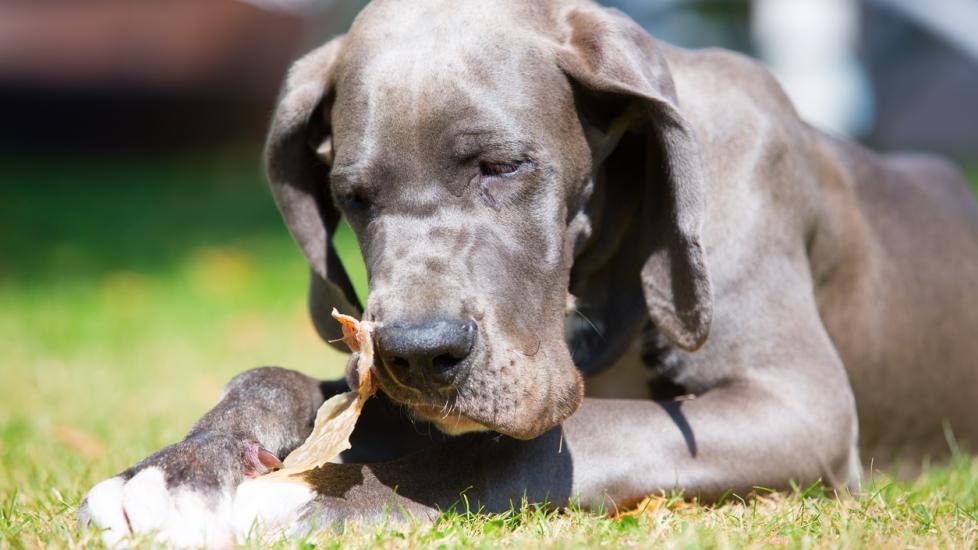Gastric Dilatation-Volvulus (GDV) Syndrome
What is Gastric Dilatation-Volvulus (GDV) Syndrome?
Gastric Dilatation-Volvulus (GDV) is a life-threatening emergency for dogs. In this condition, the stomach swells, usually with food and gas (dilatation), and twists on its axis (volvulus) in a way that the stomach contents cannot be passed into the intestines or vomited.
This swelling and twisting endanger the stomach and can also affect other nearby body systems, including the spleen and the major blood vessels of the abdomen. This can lead to severe stress on the heart, shock, and if not treated quickly, death.
GDV differs a bit from bloat in dogs. In both bloat and GDV the stomach becomes distended, but in GDV the stomach also twists on itself. The word volvulus is derived from the Latin word volvere, which means “to twist.” It is possible to have bloat (of air or food) and not have a GDV. Often, bloat can be treated medically, whereas the treatment for GDV is almost always surgical.
GDV is a medical emergency. If you suspect your dog may be experiencing GDV, take them to the nearest veterinary hospital immediately.
Health Tools
Not sure whether to see a vet?
Symptoms of Gastric Dilatation-Volvulus (GDV) Syndrome
GDV may start with mild symptoms of abdominal pain. These include inability to settle, reluctance to engage in normal activity, decreased appetite, and drooling. A balloon-like, bloated abdomen is a common finding, but it may not be easily visible. Volvulus can occur without bloat and still be severe.
An enlarged abdomen with or without frequent, non-productive retching and gagging warrants an emergency visit to the veterinarian. If symptoms are noted, especially in an at-risk breed, every minute counts. This is an emergency condition and must be treated immediately.
Causes of Gastric Dilatation-Volvulus (GDV) Syndrome
Though a specific cause of GDV has not been found, there are a few risk factors that have been confirmed. Any breed can be affected, but it is most common in the German Shepherd, Great Dane, Saint Bernard, Weimaraner, Standard Poodle, Irish Setter, Gordon Setter, and Basset Hound.
Mixed breeds with deep chests or a family history of GDV are just as likely to develop the condition. Risk increases with age, though it can also occur in young dogs.
How Veterinarians Diagnose GDV
Most vets will have a strong suspicion for GDV based on history and physical exam, but confirmation requires X-rays. A twisted stomach has a specific shape on X-ray that is easy to differentiate from simple bloat.
Bloodwork, blood pressure, and an EKG can help your veterinarian determine how severe the disease is and if there are other factors complicating treatment.
Treatment of Gastric Dilatation-Volvulus Syndrome
Treatment for GDV is almost always surgical. The veterinarian’s first goal is to relieve stress on the heart with immediate, aggressive use of IV fluids, along with relief of the bloat. This often requires sedation and passing a tube down the esophagus to allow built-up gas to escape.
After initial stabilization, your dog will be put under anesthesia, and surgery will be performed to relieve remaining gas, untwist the stomach, and evaluate the abdomen for signs of permanent damage.
Severe cases may require resection (removal) of badly affected stomach wall, intestine, and spleen. The stomach is then tacked surgically to the wall of the abdomen in an effort to prevent GDV from happening again. This is known as a gastropexy, and it has been shown to significantly reduce the likelihood of recurrence.
Recovery and Prevention of Gastric Dilatation-Volvulus Syndrome
After surgery, most dogs require hospitalization for pain medications, anti-nausea medications, and hydration. The hospital staff will also monitor your dog for complications that can occur in severely stressed body systems after surgery, such as arrhythmias (changes in heart rhythm) and blood clots.
Once sent home, dogs will rest for a few weeks as their organs heal. It is important to feed your dog frequent small meals to avoid any recurrence.
GDV is an emergency, but there are measures you can take to help prevent it. Dogs should be fed multiple small meals in a day rather than one large meal. Also, consider using a puzzle feeder or mat to slow your dog down at mealtimes. Though once commonly recommended, elevated feeding bowls may actually increase the risk of GDV and should be avoided. Avoid athletic activities immediately after eating, particularly in at-risk breeds.
Gastropexy is an essential part of preventing the recurrence of GDV, but it can also be performed at the time of neuter or spay surgery to reduce the potential for GDV to occur in the first place. Many surgical facilities offer minimally invasive laparoscopic procedures. It is highly recommended that you consult with your veterinarian about whether this procedure is advised for your dog.
Gastric Dilatation-Volvulus (GDV) Syndrome FAQs
What is the survival rate for GDV in dogs?
It has been reported that 25–30% of dogs diagnosed with GDV will die. Dogs who arrive at a veterinary clinic more than six hours after clinical signs have started have a much worse prognosis. This disease requires quick treatment.
Featured Image: iStock.com/chris-mueller
Help us make PetMD better
Was this article helpful?
